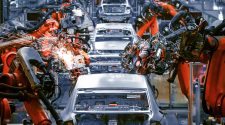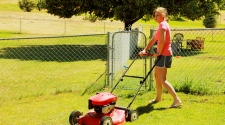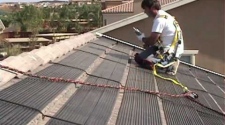The purpose of a car’s suspension system is twofold. Firstly, it must keep the driver and passengers comfortable and relatively isolated from vibrations, bumps and noise that occur from driving on less than perfectly smooth surfaces whilst protecting the car from damage. It must also allow the driver to effectively handle the car around corners and slow down the car for smooth driving as well safety. The very nature of these two goals puts them in conflict with each other as for the best handling the car’s wheels should be in contact with road as much as possible.
The solution for road isolation is to absorb as much of the energy generated from driving over bumps in the road as possible, without causing the vehicle to oscillate or bounce on its wheels. This is typically achieved by a passive spring and damper system, which is discussed a little later on. For road holding it is important to minimise the transfer of the car’s weight from left to right and front to back, as weight transfer reduces the grip of the car’s tyres on the road surface. On the other hand, weight transfer is important for cornering; whilst travelling around a corner the car’s weight should be transferred from its high side to its low side. How car suspension systems achieve this is re-visited slightly later in the article.
The very first cars were little more than horse drawn carts with engines and as a result, their suspension systems were particularly unsuited to the speeds that the new automobiles could achieve. Mors, an early French car manufacturer, was the first to fit their cars with shock absorbers as part of a dampened suspension system. The suspension was a great success; the car, dubbed the ‘Mors Machine’, won the famous Paris to Berlin race in 1901 by almost half an hour.
The next step in suspension innovation came in 1920, with a torsion bar suspension system developed by Leyland Motors. Just two years later, independent front and rear suspension appeared for the first time which, coupled with the torsion bar, would go on to form the basis of car suspension systems for almost the entire remainder of the century. The system was heavily used in armoured vehicle and tank design during the Second World War, whilst also being used in almost all cars produced by manufacturers such as Citroen, Renault and Volkswagen well into the 1950s.
By the 1960s it was Jaguar pioneering a new type of system. The front suspension consisted of a brand new torsion design whilst the rear employed the use of a set of four shock absorbers made of concentric springs. Another high performance sport car manufacturer, Porsche, also used the systems in their 911 up until the late 1980s.
In the USA, Chrysler were using a similar system and would go on to use similar designs until the early 1980s. General Motors also used the suspension systems in pickup trucks and then cars from the 1960s, continuing their use to this day in large trucks and four wheel drive SUVs. Torsion bars are manufactured right here in the UK by companies such as Brooks Forgings, a metal forging company based in the West Midlands.
In modern cars, most suspension systems are made up of passive springs, although there are several exceptions. Passive suspension refers to the fact that the system is made up of a set of traditional springs and shock absorbers (dampers). The shock absorbers dampen the response of the springs to the car’s motion along the road.
Some cars have a suspension system that is controlled by a computer, rather than being left to react to the road as the car drives along it. An active or semi-active suspension system consists of self levelling components, such as air springs, which are controlled by the car’s onboard computer and act to keep the car a certain level from the road.
Citroën are perhaps the best known manufacturers to include this type of suspension. The cars’ dashboards come equipped with a lever to allow the driver to select how high or low they would like the car to ride. When the engine is switched on, the suspension pressurises to raise it to the specified height.
















